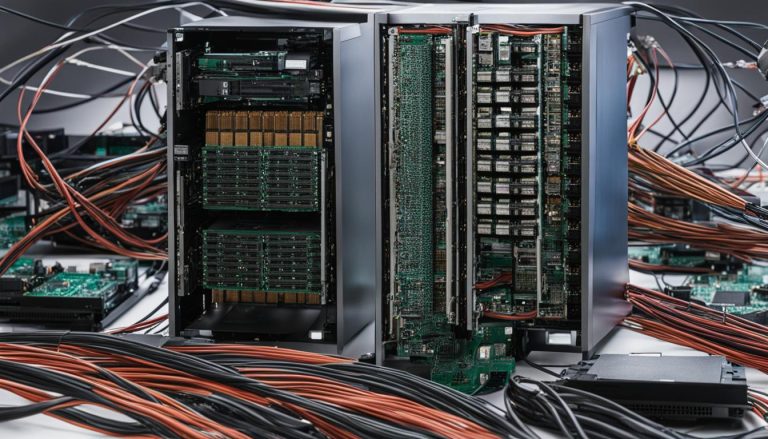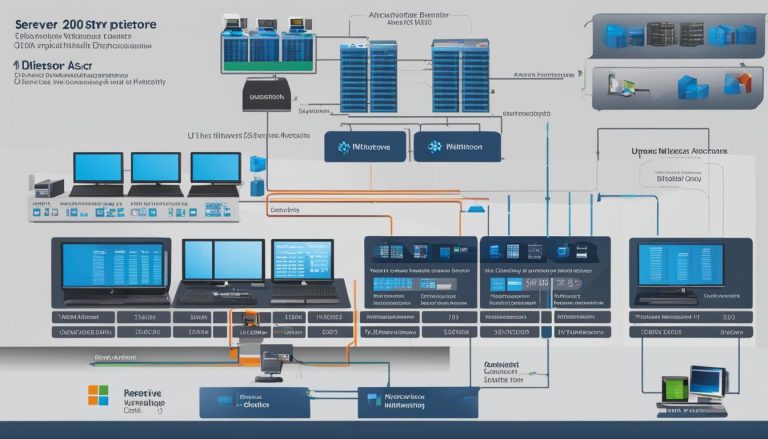Welcome to my article where I will provide you with an overview of Windows 10, the latest operating system from Microsoft. In this section, we will delve into the basics of what Windows 10 is and how it functions.
Released on July 29, 2015, Windows 10 serves as the successor to Windows 8 and powers a wide range of devices including desktops, laptops, tablets, and more. It offers a host of new features and improvements over its predecessors, with the aim of providing a user-friendly and versatile experience.
One of the standout features of Windows 10 is its incorporation of the familiar Start menu, which was absent in Windows 8. This blend of the classic Start menu with modern enhancements makes navigation a breeze. Additionally, Windows 10 introduces the ability to create virtual desktops, allowing you to organize your workspace more efficiently.
Another significant addition is the Microsoft Edge browser, which replaces Internet Explorer. With improved speed and security, Edge offers a seamless web browsing experience. Moreover, the inclusion of Cortana, the digital assistant, enables voice commands and provides personalized recommendations.
Windows 10 also prioritizes security, with enhanced features such as Windows Hello, which allows for biometric authentication, and Windows Defender, a robust antivirus and anti-malware solution. Automatic updates ensure that your system remains up to date with the latest patches and improvements.
Overall, Windows 10 offers a comprehensive and efficient operating system that caters to both personal and professional use. Its versatility, advanced features, and compatibility with a wide range of applications and devices make it an excellent choice for users.
Key Takeaways:
- Windows 10 is Microsoft’s latest operating system, released in 2015.
- It combines the familiar Start menu with modern enhancements and the ability to create virtual desktops.
- Microsoft Edge, the new browser, offers improved speed and security.
- Cortana, the digital assistant, provides voice commands and personalized recommendations.
- Windows 10 prioritizes security with features like Windows Hello and automatic updates.
Stay tuned for the next section where we will explore the exciting features and updates Windows 10 has to offer!
Windows 10 Features and Updates
Windows 10 offers a range of features designed to enhance productivity and improve user experience. The operating system incorporates the familiar Start menu, combining elements from Windows 7 and Windows 8, to provide users with a seamless transition. This allows for easy navigation and access to frequently used applications and settings.
One of the standout features of Windows 10 is the ability to run Universal Windows Platform (UWP) apps. These apps are designed to work across multiple devices, including desktops, laptops, tablets, and even Xbox consoles. This compatibility ensures that users have access to a wide range of applications, tailored to their specific needs and preferences.
Another key feature of Windows 10 is the introduction of Cortana, a virtual assistant that can help users with various tasks. With Cortana, users can perform voice commands, set reminders, search the web, and even interact with other applications. This powerful tool streamlines productivity and provides a more personalized experience.
“Windows 10 offers a range of features designed to enhance productivity and improve user experience.”
In addition to these core features, Windows 10 also includes the Microsoft Edge browser, which offers a more secure and efficient browsing experience. It is designed to be faster, more reliable, and compatible with modern web standards. Windows 10 also introduces features such as Snap Assist, which allows users to multitask by snapping windows into different layouts, and the Action Center, which provides quick access to notifications and settings.
Table: Windows 10 Features
| Feature | Description |
|---|---|
| Start menu | A familiar and customizable menu that provides access to applications, settings, and search functionality. |
| Universal Windows Platform (UWP) apps | Applications that can run across multiple devices, providing a consistent user experience. |
| Cortana | A virtual assistant that can perform tasks, provide recommendations, and answer questions. |
| Microsoft Edge | A modern and secure web browser that offers improved performance and compatibility. |
| Snap Assist | A feature that allows users to snap windows into different layouts for efficient multitasking. |
| Action Center | A centralized location for notifications and quick access to settings. |
Windows 10 is continuously being updated by Microsoft to introduce new features, enhance security, and fix bugs. These updates are delivered through the Windows Update service, ensuring that users can benefit from the latest improvements and advancements. Regular updates also contribute to the overall stability and performance of the operating system.
By combining a user-friendly interface, a wide range of features, and regular updates, Windows 10 provides a versatile and efficient operating system for both personal and professional use. Whether you’re navigating the Start menu, utilizing UWP apps, interacting with Cortana, or browsing the web with Microsoft Edge, Windows 10 offers a seamless and productive experience.
Windows 10 System Requirements and Download
In order to install Windows 10, your device needs to meet the following system requirements:
- A 1 GHz or faster processor
- 1 GB of RAM for 32-bit systems or 2 GB for 64-bit systems
- 16 GB of free storage for 32-bit systems or 20 GB for 64-bit systems
- A display with a resolution of at least 800 x 600 pixels
- A DirectX 9 graphics card
These requirements ensure that your device is capable of running Windows 10 smoothly and efficiently.
Once you have confirmed that your device meets the system requirements, you can proceed with the Windows 10 download. To download Windows 10, follow these steps:
- Go to the official Microsoft website
- Navigate to the Windows 10 download page
- Click on the “Download now” button
- Follow the on-screen instructions to complete the download
After the download is complete, you can proceed with the installation process to start using Windows 10 on your device.
| Component | Minimum Requirements |
|---|---|
| Processor | 1 GHz or faster |
| RAM | 1 GB for 32-bit / 2 GB for 64-bit |
| Storage | 16 GB for 32-bit / 20 GB for 64-bit |
| Display | 800 x 600 pixels |
| Graphics Card | DirectX 9 or later with WDDM 1.0 driver |
With the proper system requirements and a successful download, you can enjoy all the features and benefits that Windows 10 has to offer.
Windows 10 Version and Release Date
Windows 10, Microsoft’s popular operating system, has undergone several major updates since its initial release. Each update is referred to as a version, and it comes with its own set of new features and improvements. The current version of Windows 10 is version 21H1, which was released in May 2021.
Microsoft follows a semi-annual release schedule for Windows 10, with new versions typically being released in the spring and fall. These updates not only introduce new functionalities but also enhance the performance, security, and stability of the operating system. Users can expect to receive regular updates and improvements to their Windows 10 experience.
To ensure that their devices are up to date, users can manually check for updates or enable automatic updates through the Windows Update service. This way, they can stay on top of the latest version of Windows 10 and benefit from the most recent features and enhancements that Microsoft has to offer.
| Windows 10 Version | Release Date |
|---|---|
| Version 20H2 | October 2020 |
| Version 2004 | May 2020 |
| Version 1909 | November 2019 |
Table: Windows 10 Versions and Release Dates
As seen in the table above, Windows 10 has seen multiple updates over the years, each with its own version number and release date. These updates not only bring new features but also address bugs and security vulnerabilities, ensuring that users have a stable and secure operating system to work with.
Windows 10 Support
When it comes to Windows 10 support, Microsoft offers various resources to assist users with any issues or inquiries they may have. From online documentation to dedicated customer service, there are several avenues available to ensure a smooth and efficient experience with the operating system.
One of the primary sources of support is the Microsoft Support website. Here, users can access a wealth of articles, FAQs, and troubleshooting guides to help troubleshoot common problems or learn how to use specific features of Windows 10. The website is regularly updated and provides comprehensive information for users of all skill levels.
In addition to online resources, Microsoft also offers dedicated support through its customer service helpline. Users can reach out to customer service representatives who are well-equipped to assist with Windows 10-related issues. Whether it’s troubleshooting a technical problem or seeking guidance on how to optimize system performance, the customer service helpline is there to provide assistance.
Furthermore, Microsoft has community forums where users can engage with fellow Windows 10 users, share their experiences, and seek advice. These forums can be a valuable resource for troubleshooting, as they allow users to tap into the collective knowledge and expertise of the community.
Overall, Windows 10 support from Microsoft is comprehensive and readily available. Whether users prefer to seek assistance online or through direct customer service, they can count on Microsoft’s support channels to address their needs and ensure a smooth experience with the operating system.
Conclusion
After exploring the various aspects of Windows 10, it becomes evident that this operating system offers a seamless and comprehensive experience for users. Whether you’re a casual user or a professional, Windows 10 caters to your needs with its versatile features and user-friendly interface.
With the incorporation of the familiar Start menu, the introduction of virtual desktops, and the convenience of the Cortana digital assistant, Windows 10 enhances productivity and streamlines multitasking. The inclusion of the Microsoft Edge browser provides a modern and secure internet browsing experience.
Furthermore, Windows 10 prioritizes security with enhanced features and regular updates. It offers compatibility with a wide range of applications and devices, ensuring a seamless integration with your existing technology ecosystem.
In conclusion, Windows 10 is a reliable and efficient operating system that continues to evolve and adapt to the changing needs of users. With its vast array of functionalities, user-friendly interface, and ongoing support from Microsoft, Windows 10 remains the go-to choice for anyone seeking a stable and versatile Windows operating system.
FAQ
What is Windows 10?
Windows 10 is Microsoft’s latest operating system that powers desktops, laptops, tablets, and other devices.
What are some features of Windows 10?
Windows 10 introduces a variety of new features and improvements, including a refreshed Start menu, the ability to create virtual desktops, the Microsoft Edge browser, and the Cortana digital assistant.
What are the system requirements for Windows 10?
To install Windows 10, your device needs a 1 GHz or faster processor, 1 GB of RAM for 32-bit systems or 2 GB for 64-bit systems, and 16 GB of free storage for 32-bit systems or 20 GB for 64-bit systems. It also requires a display resolution of at least 800 x 600 pixels and a DirectX 9 graphics card.
What is the current version of Windows 10?
The current version of Windows 10 is version 21H1, which was released in May 2021.
How can I get support for Windows 10?
Microsoft provides support for Windows 10 through various channels, including the Microsoft Support website and its customer service helpline.
Janina is a senior specialist in information technology


